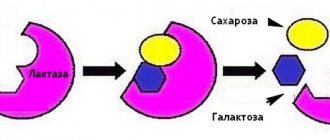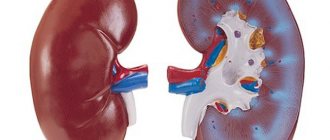Features of the pathology
Chronic adrenal insufficiency (bronze disease, Addison's disease) is a rare pathology of the endocrine system.
It is characterized by insufficient production of hormones (mineralkorticoids and glucocorticoids) by the adrenal cortex. This is due to bilateral damage to these paired endocrine glands.
With a deficiency of these hormones, muscle weakness develops, growth and sexual development are delayed, anabolic processes in muscle and bone tissue slow down, immunity decreases, and the likelihood of developing heart failure increases.
The pathology is usually diagnosed in people aged 20 to 40 years. Women are more predisposed to this disease, and in them it is much more severe than in men.
Bronze disease is characterized by a rapid course: the initial stage turns into a chronic form over a short period.
Classification
This disease can be expressed in acute and chronic forms. As a rule, acute failure may be accompanied by shock due to a sharp drop in blood pressure, shortness of breath, and in rare cases, convulsions and loss of consciousness. This is the most severe condition when hormones suddenly stop being produced, which can lead to serious consequences.
The chronic form of hypocortisolism may not manifest itself for several years, and occurs only under severe stress conditions. Typically, at this time, the body requires cortisol to replenish lost energy reserves, coordinate glucose production, brain activity and the cardiovascular system. And with its deficiency, the condition worsens sharply, which can lead to an exacerbation of the disease and transition to an acute dangerous form.
Chronic adrenal insufficiency, in turn, is divided into several types:
- Primary failure, in which the adrenal glands are directly affected. And it is the most severe and most common, it can be congenital and acquired.
- Secondary hypocortisolism occurs when the pituitary gland is damaged, when ACTH hormones are produced in insufficient quantities or this organ stops synthesizing them altogether.
- Tertiary adrenal insufficiency is always associated with damage to the central organ of the hypothalamus, and like the two previous types, it can have a congenital and acquired form.
Primary deficiency may be associated with genetic inheritance, but does not necessarily manifest itself in infancy, but appears many years later.
Congenital adrenal hypoplasia in its acute form manifests itself immediately after the birth of a child, and less commonly manifests itself in adolescence and adulthood. Mostly men are affected by this disease, which is associated with a mutation in the DAX1 gene, located on the Xp21 chromosome and involved in the synthesis of hormonal receptors.
Congenital hypoplasia may be a manifestation of a gene sequence in association with mental retardation, glycerokinase deficiency, and muscular dystrophy.
Factors in the development of the disease
Addison's disease develops under the influence of such negative factors as:
- damage to the adrenal cortex of an autoimmune nature;
- severe infectious or viral diseases (usually tuberculosis or syphilis);
- hemorrhages in the adrenal glands;
- tumor of paired endocrine glands or the presence of metastases in them;
- genetic pathologies (familial adrenal hypoplasia, adrenoleukodystrophy, familial hypoadrenocorticism);
- damage to adrenal tissue by toxic substances;
- brain injuries that damage the anterior pituitary gland;
- AIDS;
- brain irradiation;
- injuries sustained by the baby during childbirth;
- therapy of certain diseases associated with the use of corticosteroids. Similar drugs are used for lupus erythematosus, asthma, and ulcerative colitis.
These reasons provoke partial or complete atrophy of the adrenal cortex. Under such conditions, the synthesis of hormones necessary for the full functioning of internal organs sharply decreases. With chronic insufficiency of paired endocrine glands, a failure occurs in the metabolic process.
Causes of adrenal insufficiency
Most often (98%) the cause of the development of primary adrenal insufficiency is atrophic changes in the adrenal cortex of an idiopathic nature . It is known that in this case, autoimmune antibodies to the enzyme 21-hydroxylase are formed in the body, which have a destructive effect on healthy tissues and cells of the adrenal glands.
The causes of the disease in question may be:
- Pulmonary tuberculosis. In this case, doctors will diagnose tuberculosis of the adrenal glands, which causes the development of the disease in question.
- Adrenoleukodystrophy is a rare genetic disease. In this case, a genetic defect occurs on the X chromosome and there is a deficiency of the enzyme that should break down fatty acids. It turns out that dystrophy of the adrenal cortex is provoked by fatty acids, which, with such a genetic defect, accumulate in the tissues.
- Coagulopathies, bilateral adrenal infarction, metastases of malignant tumors that are localized in the mammary gland or lungs, HIV-associated infections, surgical removal of the adrenal glands - these conditions are provoking factors in relation to the primary form of the pathology in question.
- Severe suppurative diseases, syphilis, fungal infections and amyloidosis of the adrenal glands, malignant tumors, heart defects, the use of certain medications (anticoagulants, steroidogenesis blockers, ketoconazole, cloditan, spironolactone, barbiturates) are predisposing factors that cause the development of atrophy of the adrenal cortex.
Secondary adrenal insufficiency can be triggered by pathological processes in the hypothalamus or pituitary gland (tumors or structural disorders), which leads to disruption of corticotropic function, resulting in:
- neoplasms of the hypothalamus and pituitary gland;
- diseases of the vascular system - for example, hemorrhages in the pituitary gland/hypothalamus, carotid artery aneurysm;
- pathological processes of a granulomatous nature in the hypothalamus or pituitary gland;
- destructive and traumatic interventions: radiation therapy carried out directly in the area of the hypothalamus and pituitary gland, various surgical interventions, surgeries, treatment with glucocorticoids for a long time.
Primary adrenal insufficiency will be characterized by a decrease in the secretion of adrenal hormones (cortisol and aldoatherone), which results in disturbances in metabolic processes and water-salt balance. If there is an aldosterone deficiency, then progressive dehydration will certainly be noted, which is caused by loss of sodium and potassium retention (hyperkalemia) in the body. In parallel with this, the patient will experience functional disturbances in the functioning of the digestive system, heart and blood vessels - the provoking factor in this case will be a violation of the water-salt balance.
As the pathology in question progresses, the level of cortisol sharply decreases, which leads to a deterioration in the processes of glycogen synthesis and ultimately leads to the development of hypoglycemia . In conditions of cortisol deficiency, the pituitary gland begins to overproduce enzymes and melanocyte-stimulating hormone, which is manifested by active pigmentation of the skin and mucous membranes. Numerous physiological stresses (including trauma, infections, chronic inflammatory and infectious diseases) cause the progression of primary adrenal insufficiency. Secondary adrenal insufficiency, compared to primary one, is relatively mild.
Pathogenesis of the disease
The development of chronic adrenal insufficiency is based on a deficiency of hormones produced under normal conditions by the adrenal cortex.
A lack of mineralcorticoids (in particular, aldosterone) contributes to accelerated removal of sodium from the body and potassium retention. Electrolyte imbalance contributes to dehydration, decreased blood volume, and decreased blood pressure.
Deficiency of mineralcorticoids disrupts the synthesis of sex hormones: in adolescence, this becomes the cause of delayed sexual development. In adults, chronic adrenal insufficiency causes reproductive dysfunction.
When the synthesis of glucocorticoids, the most active of which is cortisol, is disrupted, the body's anti-inflammatory defense is significantly reduced, brain function slows down, and the ability to replenish energy reserves is reduced. In addition, the body’s ability to withstand stress during shock, injury, and massive blood loss decreases.
The result of glucocorticoid deficiency manifests itself in skin pigmentation, which is caused by an increase in the blood of a substance that has a melanocyte-stimulating effect, as well as in the development of heart failure, and a decrease in the energy reserves of glycogen in the liver.
Acute stages
ONI manifests itself in the form of Addisonian crisis. Its duration can be from 2-3 hours to 2-3 days. Characteristic is the sequential appearance of disorders in accordance with the stages:
| Acute stages | Short description |
| Initial | Weakness increases, darkening of the skin (with exacerbation of chronic insufficiency), nausea, headache are noted, appetite and blood pressure decrease. Medicines with a vasoconstrictor effect do not eliminate hypotension; it is corrected only by hormones |
| Expressed manifestations | Patients are exhausted, exhausted, abdominal pain and uncontrollable vomiting, fever appear, dehydration progresses, urine ceases to be excreted, and blood pressure drops catastrophically |
| Coma | Consciousness and reflexes disappear, body temperature drops, death is likely to occur |
If acute insufficiency is caused by thrombosis or hemorrhage, then the first stage may not occur.
Clinical picture
The symptoms of adrenal insufficiency are quite different, so it is worth paying attention to which signs predominate in order to make the correct diagnosis. The most severe manifestation of the disease is Addisonian, or adrenal, crisis.
Adrenal crises: general characteristics
Adrenal crisis (adrenal, addisonic) is an acute condition that is a complication of chronic adrenal insufficiency.
Signs of this condition are:
- inhibition of the patient’s reaction (slurred speech, weakness, apathy);
- decreased skin elasticity, dry skin;
- convulsions, hallucinations, disturbance of temporal and spatial orientation;
- rapid pulse;
- blood appearing in feces and vomit;
- a decrease in the amount of urine excreted or a complete cessation of urination;
- severe sweating;
- decrease in body temperature;
- a sharp decrease in pressure level.
Possible consequences of a crisis include critical cardiac arrhythmia, shock, acute renal failure, coma and death. The condition is characterized by high mortality rates (40-50% of cases). If the necessary measures are taken in a timely manner, the patient’s condition can be stabilized. In this case, you can count on a favorable prognosis.
Manifestations of the disease and men
Chronic adrenal insufficiency develops slowly and manifests itself in a variety of symptoms. Common signs include the following:
- changes in the color of the skin and mucous membranes, the development of hyperpigmentation, it is this manifestation that led to the name of chronic adrenal insufficiency as “bronze disease”, this is the first characteristic symptom of a developing pathology;
- chronic decrease in blood pressure, which leads to constant dizziness and chills;
- potency disorders;
- sudden weight loss (5-15 kg or more);
- behavioral disorders - severe irritability, depression, apathy;
- muscle pain and muscle weakness, which can be so severe that it causes disability;
- increased sensitivity to taste, auditory, olfactory stimuli. It has been noticed that people suffering from Addison's disease feel a constant need for salty food;
- disruptions in the functioning of the digestive system (nausea, diarrhea);
- wandering abdominal pain;
- decreased libido.
Signs in women
Adrenal insufficiency in women has the same symptoms as in men. The clinical picture is complemented by the cessation of menstruation, loss of hair growing on the pubis and in the armpits, loss of skin elasticity, formation of hollows around the eyes and in the cheek area, and decreased libido.
Symptoms
The first signs may appear immediately after birth or many years later. The pathology develops gradually, with general weakness, fatigue, sudden weight loss, low blood pressure, and all this may be accompanied by nausea and vomiting. Therefore, if such symptoms appear, you should immediately consult a doctor.
With primary hypocortisolism, patients experience strong pigmentation of the epidermis and mucous membranes; a concomitant disease, vitiligo, that is, the appearance of white spots on the body, may develop. With this disease, indigestion occurs, the person becomes irritable or, on the contrary, falls into an apathetic state.
Diagnostic measures
In order to make an accurate diagnosis, the following activities are carried out:
- general blood test (to determine the degree of blood thickening, as well as the level of sodium and potassium);
- general urinalysis (with its help, a decrease in hormone metabolic products is detected);
- Ultrasound or computed tomography of the adrenal glands;
- MRI of the brain;
- X-ray examination of the abdominal organs.
Immediately after diagnosis, a course of adequate treatment is determined.
Methods of therapy
Addison's disease requires complex treatment, which involves taking medications and following a special diet.
The main task in treating the disease is to compensate for the deficiency of hormones produced under normal conditions by the adrenal cortex.
During hormone replacement therapy, the patient is prescribed synthetic glucocorticoids. Hydrocortisone, Dexamethasone, and Fludrocortisone are used.
The patient is also advised to take measures aimed at restoring water and electrolyte balance. For this purpose, droppers with saline solution are prescribed. When the concentration of glucose in the blood decreases, a solution of this substance (5%) is administered intravenously.
For tuberculosis infection, the patient is prescribed antibiotics - Isoniazid, Streptomycin.
Necessary diet
Patients suffering from adrenal pathology must follow a special diet. You should:
- exclude foods with excess potassium content (bananas, potatoes, dried fruits, nuts, legumes);
- consume enough salt (up to 20 g per day), since pathology reduces sodium content;
- include in the menu foods rich in vitamins B1 (bran, yeast, liver) and C (citrus fruits, currants, rose hips);
- eat fish, meat and vegetables only in boiled form;
- eat small meals, several times a day, but in small portions. Before going to bed, you should drink a glass of milk.
It is recommended to use decoctions of rose hips, echinacea, and string. They have a general strengthening effect, increasing immunity.
Effective directions of therapy
The treatment tactics that the doctor will select depends on the causes of the syndrome in the woman and the stage of the pathological process. Treatment goals: stop the primary disease, compensate for hormonal deficiency.
READ ALSO: What is Addison's disease: how does it manifest and how to treat damage to the adrenal cortex and deficiency of hormone synthesis
In case of acute adrenal insufficiency, the action plan should be as follows:
- the patient is admitted to the hospital;
- NaCl solution up to 2 liters per day is administered intravenously;
- it is necessary to administer a glucose solution, as well as Prednisolone, followed by a reduction in its dosage.
Medications
After stabilization of the condition, maintenance hormonal therapy with glucocorticoids and mineralcorticoids is carried out, which is permanent:
- Cortisone;
- Cortef;
- Didn't work;
- Retabolil.
For mild hypocortisolism, take Cortisone or Hydrocortisone; if the disease is advanced, use combinations of Cortisone or Hydrocortisone with Prednisolone. If the therapy is effective, patients experience a decrease in skin pigmentation, blood pressure stabilizes, and weight gain occurs.
In the secondary form of adrenal insufficiency, only glucocorticoids are used, without the use of aldosterone drugs. In case of stressful effects (trauma, surgery, infection), the dosage of hormonal drugs is increased.
Features and rules of nutrition
One of the components of complex treatment of hypocortisolism should be diet. Basic principles of nutrition:
- enriching the diet with proteins;
- high calorie foods;
- increasing the intake of vitamins C and B;
- increasing the amount of salt;
- limiting foods containing potassium.
For accompanying symptoms (gastrointestinal disorders, cardiac dysfunction), symptomatic treatment is carried out. In the presence of tumor formations in the adrenal glands, the hypothalamic-pituitary system, surgical intervention is performed. Adequate treatment allows women with hypocortisolism to improve their quality of life and avoid complications associated with adrenal hormone deficiency.
Learn about the symptoms of left adrenal hyperplasia and methods of treating the pathology.
What the hormone cortisol is responsible for in men and the normal levels of the anti-stress regulator is written on this page.
Go to https://vse-o-gormonah.com/vnutrennaja-sekretsija/gipofiz/gormony.html and read about what hormones the pituitary gland produces and why the body needs them.
Forecasts and preventive measures
Timely treatment and correct therapy methods make the prognosis of bronze disease relatively favorable. The patient's life expectancy does not decrease.
In 80% of cases, the development of adrenal pathology is associated with autoimmune processes, so there are no effective means to prevent the development of pathology.
It is possible to protect yourself from Addison's disease if you work to strengthen your immune system, avoid contact with toxic substances, undergo timely examinations and treat existing infectious and other diseases.
Persons with a genetic predisposition to the development of pathology need to avoid exhausting physical activity, as well as psycho-emotional stress.
Addison's disease is a serious disease of the endocrine system, which manifests itself in general weakening of the body and dysfunction of organs. The most severe manifestation of the pathology is a crisis, which can provoke coma and death of the patient. Timely treatment can save the patient’s life.
Prognosis for adrenal insufficiency
If the diagnosis and administration of hormone replacement therapy was made in a timely manner, then the course of the pathology in question will be favorable.
No specialist will give an unambiguous prognosis for adrenal insufficiency, since this depends on the implementation of measures to prevent adrenal crises. Moreover, such measures should be carried out taking into account acquired infections, injuries and somatic diseases - patients will need to increase the dose of the hormone taken.
Adrenal insufficiency is considered a fairly dangerous disease, which can be fatal if left untreated. On the contrary, if the patient strictly follows the doctor’s instructions and regularly undergoes preventive examinations, the prognosis will be more than favorable.
Konev Alexander, therapist
8, total, today
( 191 votes, average: 4.63 out of 5)
Androgenetic alopecia in women
Euthyroidism: symptoms and treatment











